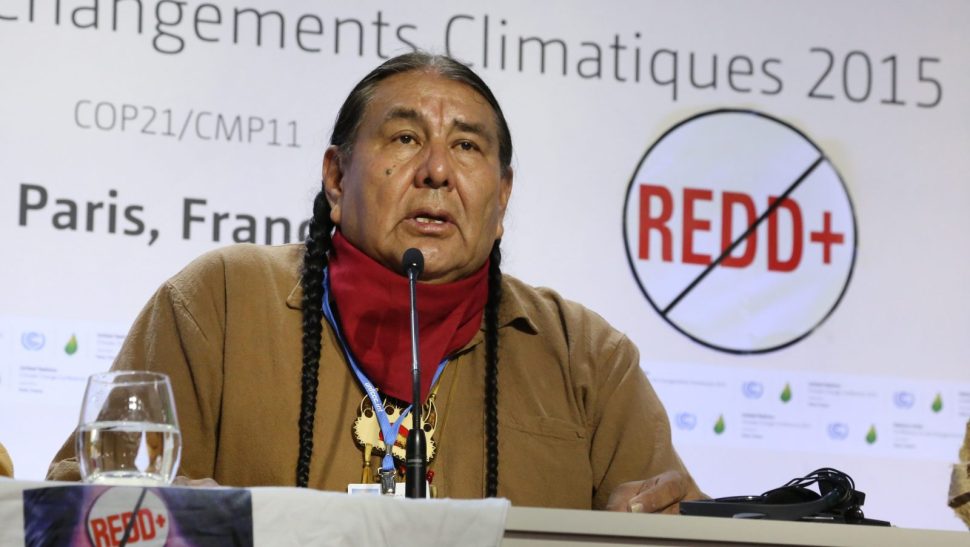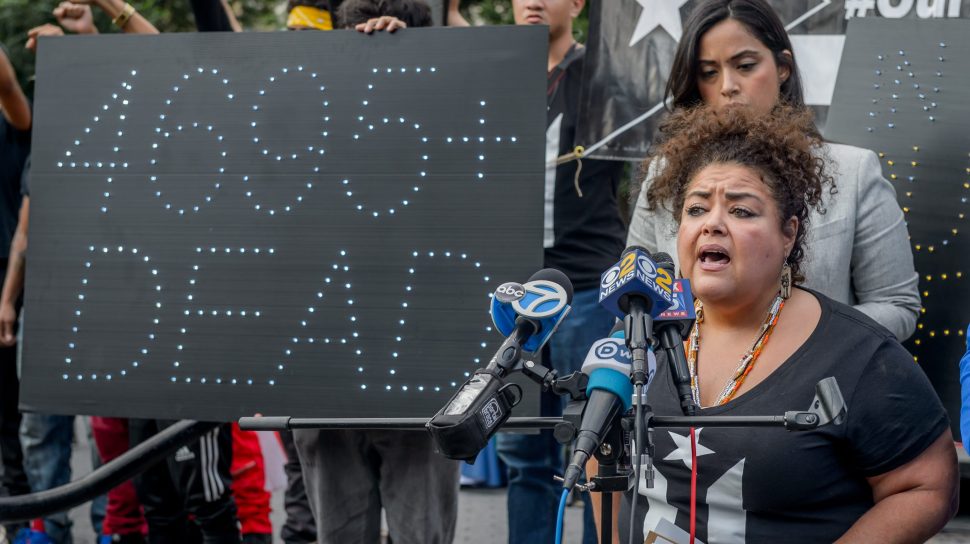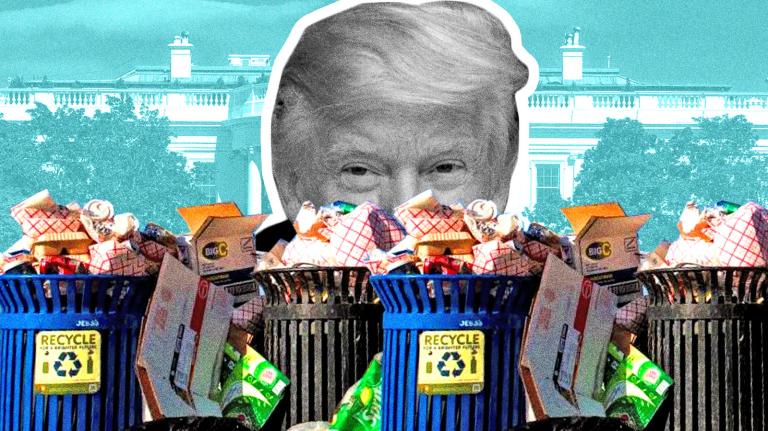Alexandria Ocasio-Cortez. Elizabeth Warren. Beto O’Rourke. Those are just a few of the high-profile names either leading the development of or jumping to endorse today’s environmental cause célèbre, the Green New Deal. Inside congressional halls, at street protests, and, of course, on climate Twitter — it’s hard to avoid the idea, which aims to re-package ambitious climate actions into a single, wide-ranging stimulus program.
The Green New Deal is being promoted as a kind of progressive beacon of a greener America, promising jobs and social justice for all on top of a shift away from fossil fuels. It’s a proposal largely driven by newcomers to politics and environmental activism (and supported, however tentatively, by several potential presidential candidates and members of the Democratic political establishment). The plan aspires to bring together the needs of people and the environment, outlining “a historic opportunity to virtually eliminate poverty.”
But within the broader environmental movement, not everyone was initially gung-ho on the Green New Deal — at least not without some stipulations.
To understand the debate surrounding the Green New Deal, you need to look beyond its recent prominence in Beltway political circles to the on-the-ground organizations that make up the environmental justice movement. Newcomers like Ocasio-Cortez may be leading the charge, but grassroots leaders who have spent years advocating for low-income families and neighborhoods of color most impacted by fossil fuels say their communities weren’t consulted when the idea first took shape.
For all the fanfare, there isn’t a package of policies that make up a Green New Deal just yet. And that’s why community-level activists are clamoring to get involved, help shape the effort, and ensure the deal leaves no one behind.
Something Old, Something New

This past November, 150 youth activists and newly elected Democratic Representative Alexandria Ocasio-Cortez held an hour-long sit-in in Nancy Pelosi’s office in D.C. Sunrise Movement
Although the term “Green New Deal” has evolved over time, its current embodiment as a complete overhaul of U.S. energy infrastructure was spearheaded by two high profile entities: progressive darling and first-term Representative Alexandria Ocasio-Cortez, and the Sunrise Movement, an organization formed in 2017 by young people hellbent on making climate change the “it” issue.
In November 2018, Ocasio-Cortez, with support from Sunrise, called for a House select committee to formulate the package of policies. More than 40 lawmakers signed on to support the draft text. Then shortly before the end of the year, Nancy Pelosi, now the speaker of the House, announced the formation instead of a “Select Committee on the Climate Crisis.”
It wasn’t exactly a win for the leaders of the new environmental vanguard. Sunrise tweeted its displeasure at the committee’s pared-down ambition, taking umbrage with its lack of power to subpoena (a condition for which Ocasio-Cortez had advocated) and the fact that politicians who take money from fossil fuel interests would not be excluded from sitting on it.
The fuss over who gets a say in the formation of the Green New Deal goes back further than Ocasio-Cortez’s or Sunrise’s friendly-ish feud with establishment Democrats. The Climate Justice Alliance, a network of groups representing indigenous peoples, workers, and frontline communities, says its gut reaction to the Green New Deal was that it had been crafted at the “grasstops” (as opposed to the grassroots).
Shortly after Ocasio-Cortez put out her proposal for a select committee, the alliance released a statement largely in support of the concept, but with a “word of caution”: “When we consulted with many of our own communities, they were neither aware of, nor had they been consulted about, the launch of the GND.”
Leaders at the alliance surveyed its member organizations — there are more than 60 across the U.S. — and put together a list of their concerns. Unless the Green New Deal addresses those key points, the alliance says, the plan won’t meet its proponents’ lofty goal of tackling poverty and injustice. Nor will the deal gain the grassroots support it will likely need to become a reality.
“What we want to do is strengthen and center the Green New Deal in environmental justice communities that have both experience and lived history of confronting the struggle against fossil fuel industries,” Angela Adrar, executive director of the alliance, told Grist.
Grist asked several indigenous and environmental justice leaders: If the Green New Deal is going to make good on its promises, what will it take? Here’s what they said.
A more inclusive and democratic process that respects tribal sovereignty
As details get hashed out on what a Green New Deal would actually include, longtime environmental justice organizers say their communities need to be the ones guiding the way forward. “The way that the plan was developed and shared is one of its greatest weaknesses,” Adrar says. “We want to be able to act quickly, but we also want to act democratically.”
She adds that involving the grassroots is especially important in the wake of the 2018 midterm elections, which ushered in many new congressional members pledging to focus on the underrepresented communities they come from. The Climate Justice Alliance is calling for town halls (with interpreters for several languages) to allow communities to help flesh out policies to include in the Green New Deal.

Tom Goldtooth, director of Indigenous Environmental Network opposing REDD (Reducing Emissions from Deforestation and Degradation) at a press conference at the 2015 U.N. climate talks in Paris, France. Patrick Aventurier / Getty Images
Some of the disconnect could be generational, says Tom Goldtooth, executive director of the Indigenous Environmental Network. Many of the leaders espousing the Green New Deal are young people. He says that he and his colleagues were caught off-guard when they saw the plan on social media and that when his network reached out to its members, there was little familiarity or understanding of the Green New Deal.
“Maybe the way of communication of youth is different than what we’ve found in the environmental justice movement and our native movement around the value of human contact — face-to-face human contact,” he says. “We’re asking that leadership of the Green New Deal meet with us and have a discussion how we can strengthen this campaign with the participation of the communities most impacted.”
Any retooling of America’s energy infrastructure will undoubtedly venture into Native American tribes’ lands, where there are already long-standing battles over existing and proposed pipeline expansions, as well as fossil fuel facilities. The United Nations Declaration on the Rights of Indigenous Peoples calls for “free, prior, and informed consent” from tribes before developers begin any project on their land. So indigenous environmental groups say there needs to be respect for tribal sovereignty and buy-in from tribes for a Green New Deal to fulfill its promise of being just and equitable.
Green jobs should be great jobs
There has been a lot of talk in Green New Deal circles about uplifting poor and working-class communities. Advocates have floated ideas ranging from a job-guarantee program offering a living wage to anyone who wants one to explicitly ensuring the rights of workers to form a union.
But as workers’ rights organizations point out, energy and extractive industries have provided unionized, high-paying jobs for a long time — and they want to make sure workers can have the same or a better quality of life within green industries.
“There’s been a long history of workers that have been left hanging in transition in the past,” says Michael Leon Guerrero, executive director of the Labor Network for Sustainability, which has been working to bridge divides between labor and environmental issues. “For that reason, there’s quite a bit of skepticism in the labor sector.”
Joseph Uehlein, who founded the Labor Network for Sustainability, adds that there needs to be more than just the promise of jobs to entice labor to support a Green New Deal. “Every presidential candidate in my lifetime talks about job creation as their top priority,” he says. “Over the last 40 years, those jobs have gotten worse and worse. A lot of jobs are not so good, requiring two or three breadwinners to do what one used to be able to do.”
Uehlein hopes an eventual Green New Deal will ensure not just jobs that guarantee a living wage, but will go one step further. “We always talk about family-supporting jobs,” he says. “It’s not just about living, it’s about supporting families.”
Do No Harm
Any version of a Green New Deal would likely ensure that the U.S. transitions away from fossil fuels and toward renewable sources of energy — with Ocasio-Cortez setting the bold target of the nation getting 100 percent of its energy from renewables within 10 years.
But defining what exactly counts as “renewable energy” has been tricky. There are plenty of sources of energy that aren’t in danger of running out and don’t put out as many greenhouse gases as coal or oil, but are still disruptive to frontline communities. Garbage incineration is considered a renewable energy in some states, but it still emits harmful pollutants. And when it comes to nuclear energy or large-scale hydropower, the associated uranium extraction and dam construction have destroyed indigenous peoples’ homes and flooded their lands.
The Climate Justice Alliance is also pushing to exclude global warming interventions like geoengineering and carbon capture and sequestration, which they believe don’t do enough to address the root causes of global warming. Both technologies have to do with re-trapping or curbing the effects of greenhouse gases after they’ve been produced. “Carbon capture and sequestration, it’s a false solution from our analysis,” Goldtooth says. The focus needs to be on stopping greenhouse gases from getting into the atmosphere in the first place, he and other critics argue.
As the alliance sees it, a future in which the planet survives requires a complete transition away from fossil fuels and an extractive economy, and toward a regenerative economy with less consumption and more ecological resilience.
Goldtooth and his colleagues are calling for solutions that rein in damaging co-pollutants on top of greenhouse gases. And they support scalable solutions — like community solar projects — that are are popping up in some of the neighborhoods that are most affected by climate change.
A good start
Even though the Green New Deal faces many political obstacles, its proponents are still pushing forward at full speed. “We are calling for a wartime-level, just economic mobilization plan to get to 100% renewable energy ASAP,” Ocasio-Cortez tweeted on New Year’s Day.
Scientists recently estimated that the world has only 12 years to keep average global temperatures from increasing beyond 1.5 degrees Celsius (2.7 degrees Fahrenheit) — the upper limit which many agree we can’t surpass if we want to avoid a climate crisis. The urgency around the latest climate change timeline has brought a lot of new advocates to the table.
According to John Harrity, chair of the Connecticut Roundtable on Climate and Jobs and a board member at the Labor Network for Sustainability, the labor movement is becoming more willing to engage on ways to address climate change. “I think the Green New Deal becomes a really good way to put all of that together in a package,” he says. “That evokes for a lot of people the image of a time when people did all pull together for the common good.”
Elizabeth Yeampierre, steering committee co-chair of the Climate Justice Alliance and executive director of the Brooklyn-based grassroots organization, UPROSE, which works on issues cutting across climate change and racial justice, calls the Green New Deal “a good beginning for developing something that could really have lasting impacts and transformation in local communities and nationwide.”
Since the alliance put out its recommendations, Yeampierre says she’s been in regular contact with both the Sunrise Movement and Ocasio-Cortez’s office. “To their credit they were responsive and have made themselves available to figure out how we move forward in a way that doesn’t really step over the people,” she explains.
Yeampierre, Goldtooth, and other representatives of the Climate Justice Alliance met with Representative Ocasio-Cortez on Thursday*. In a video, Ocasio-Cortex said the purpose of the meeting was to figure “how we can bring the direct communities impacted into the space of leadership so they can draft and lead a Green New Deal.”
“We need to be able to trust that communities can govern themselves and I’m so excited to have heard and uplift those solutions,” she said.

Executive Director of UPROSE Elizabeth Yeampierre demands justice for Puerto Rico on the one-year anniversary of Hurricane Maria at a gathering in New York City’s Union Square. Erik McGregor / Pacific Press / LightRocket via Getty Images
The language in Ocasio-Cortez’ draft proposal has already changed — it now includes clauses to “protect and enforce sovereign rights and land rights of tribal nations” and “recognize the rights of workers to organize and unionize.” The document has doubled in length since it was put out in November (at time of publication, it is 11 pages long) and will likely include new edits in the coming days.
Varshini Prakash, a founding member of the Sunrise Movement (and a 2018 Grist 50 Fixer), says she agrees with the Climate Justice Alliance’s recommendation that a Green New Deal prioritize the needs of workers, frontline communities, communities of color, and low-income communities. “Their critiques,” Prakash tells Grist, “are fully valid, and I appreciate what they’re bringing.”
The broad overview of a Green New Deal in Ocasio-Cortez’s proposal for a select committee, Prakash says, was hashed out quickly after the representative’s team approached Sunrise late last year. (Ocasio-Cortez did not immediately respond to Grist’s inquiry). “This was very rapid fire, it happened on an extremely tight timescale,” she says. “We didn’t have a lot of time to do the broad consultation we wanted.”
But Prakash, Yeampierre, and other leaders in the movements for environmental and climate justice are working to make sure there are more folks on board moving forward.
“Climate change isn’t just going to threaten our communities — it’s also going to test our solidarity, it’s going to test how we build relationships with each other,” Yeampierre says. “So I think the Green New Deal can be used as an opportunity to show that we can pass that test.”
*This post has been updated to include Ocasio-Cortez’s meeting with the Climate Justice Alliance.




